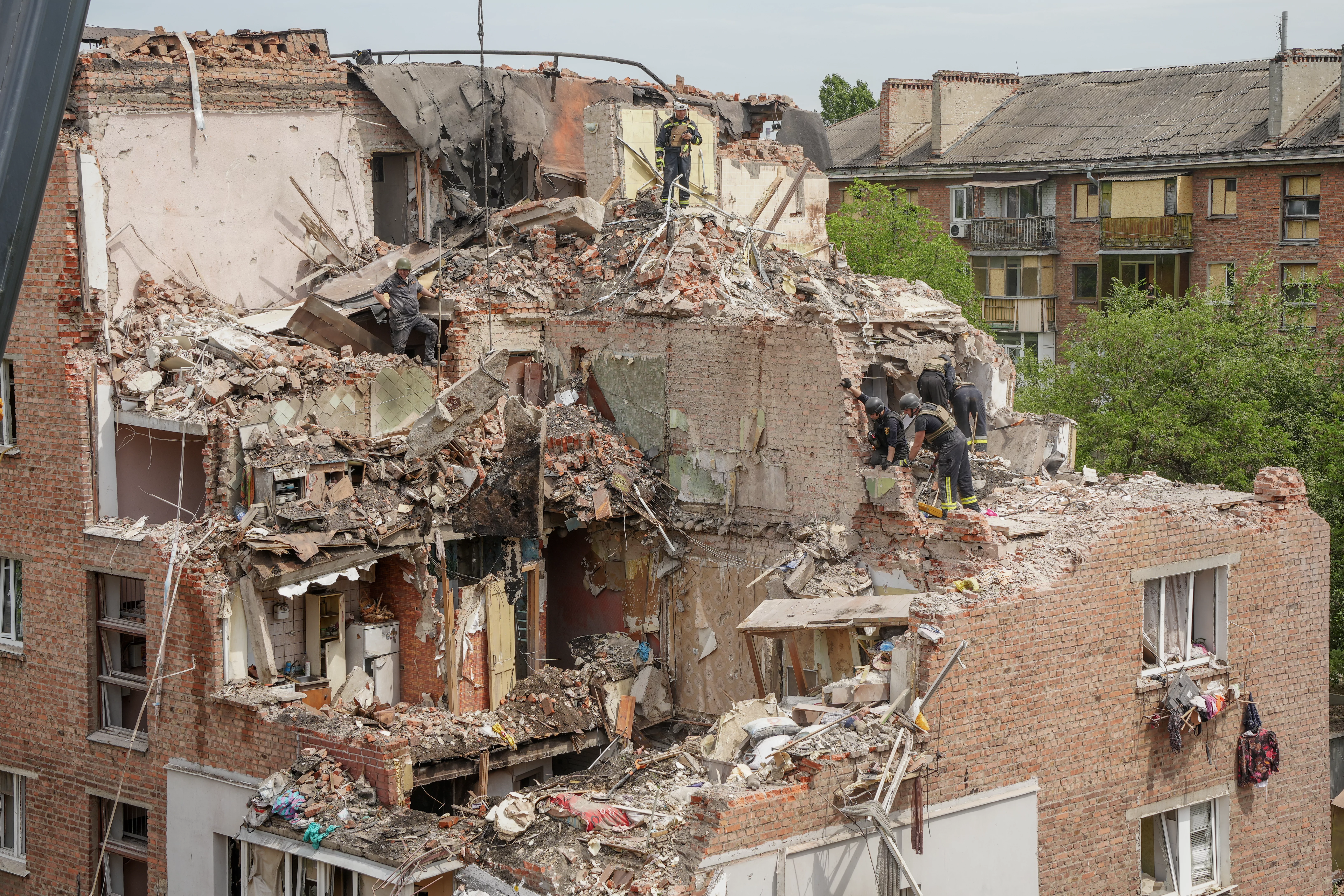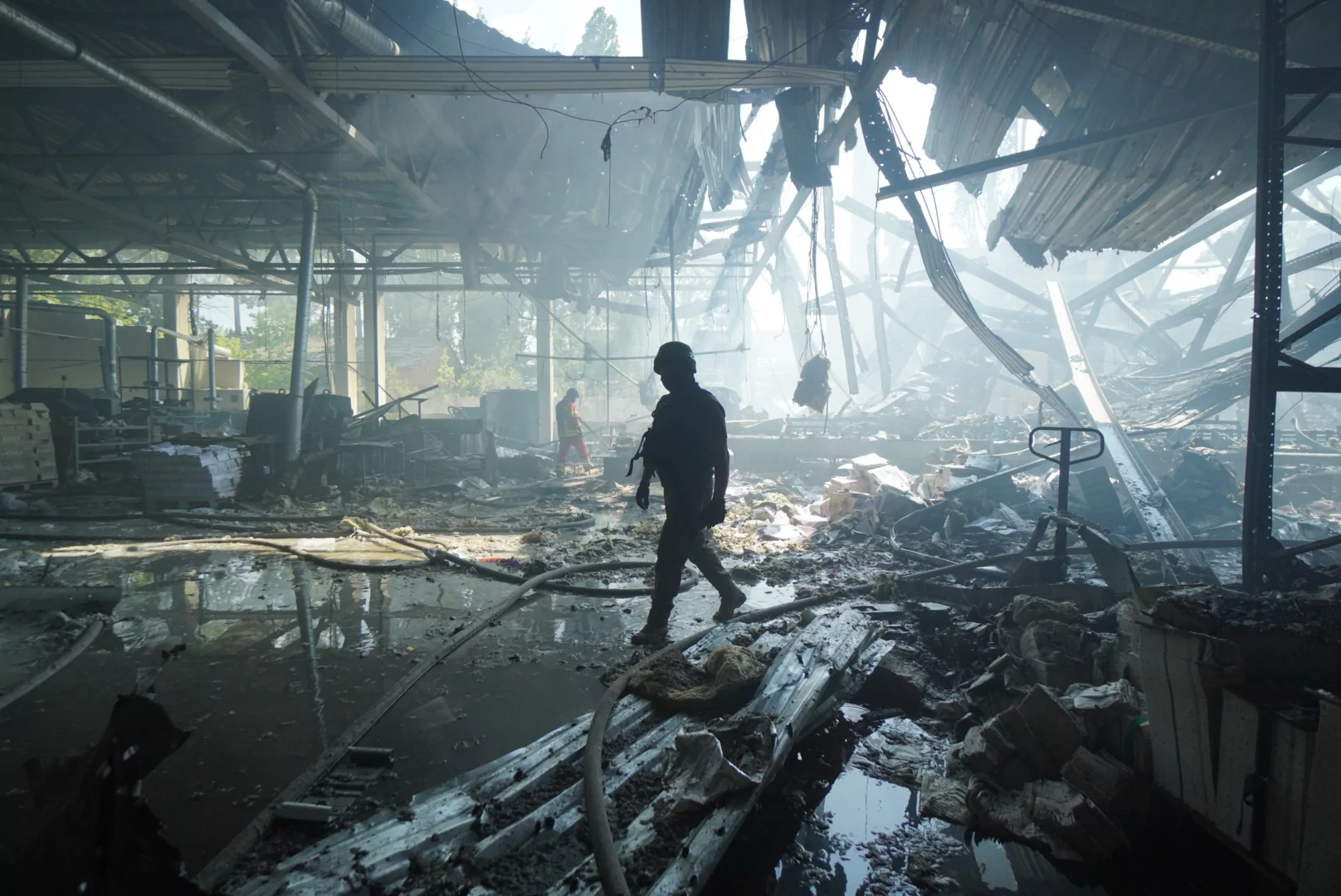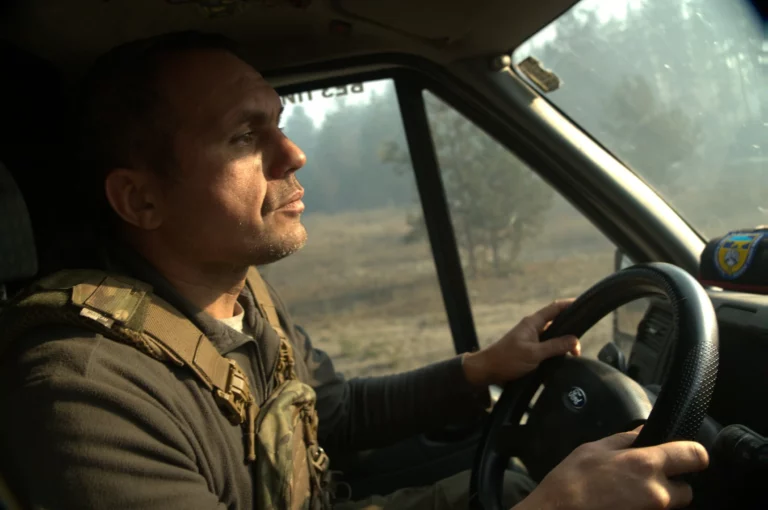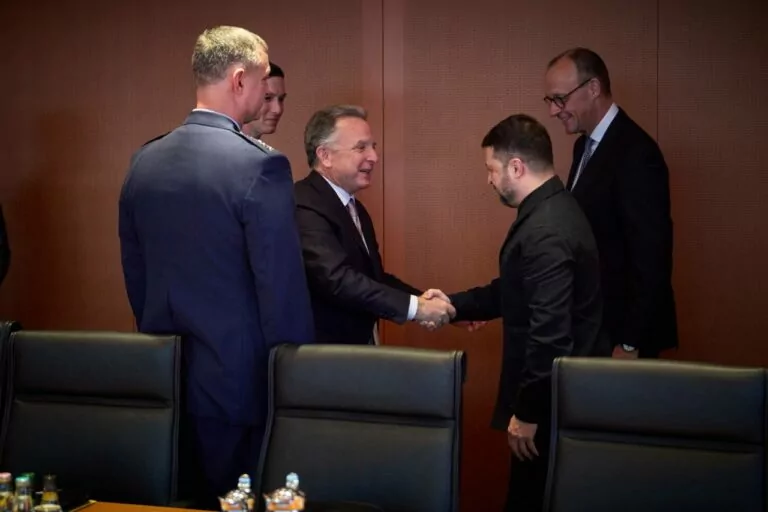More than a month has passed since Russia started a new offensive north and northeast of Kharkiv Oblast, towards Lyptsi and Vovchansk. That was the first major ground assault of the Russian-Ukrainian war since 2022.
It wasn’t a surprise that Russia led an attack on the region, but Kyiv expected it to happen in late May or early June. On the morning of May 10, Russians moved in small sabotage groups across the border, like they periodically had since the Kharkiv counteroffensive pushed them out of Ukraine in this region.
After digging into the territory, these groups called for military equipment, supporting their advance with artillery, drone, and glide bomb attacks both on Ukrainian positions and deep in the rear, striking Kharkiv, the second-largest city in Ukraine.
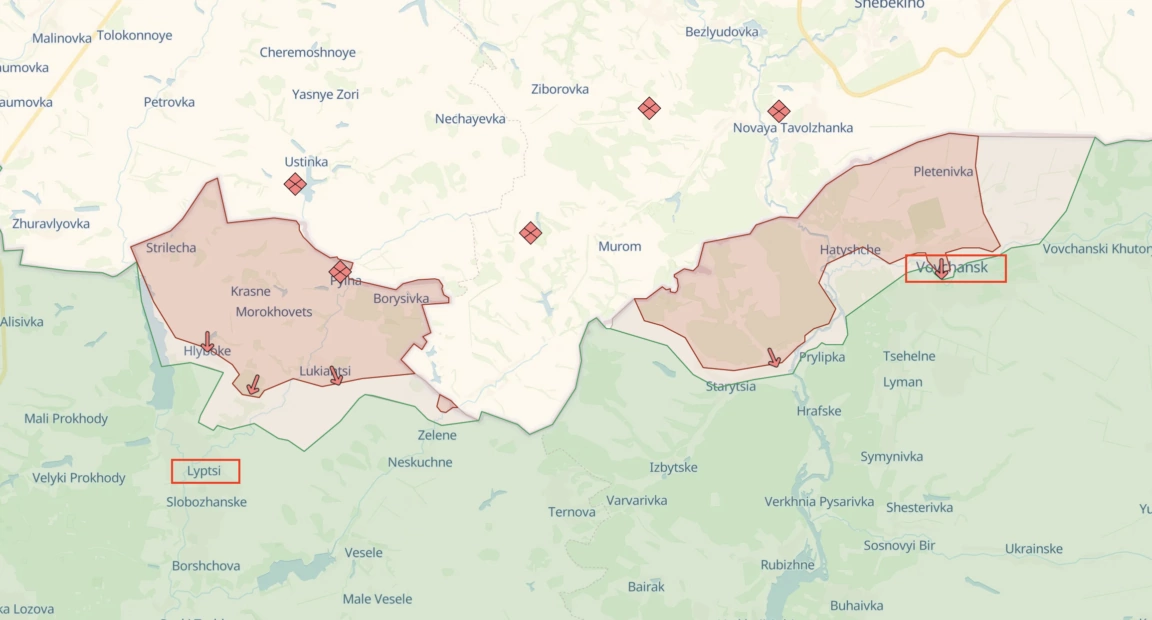
Russia’s territorial gains
In one month, Russia has made moderate territorial gains but has firmly occupied several villages near the border and almost completely destroyed the city of Vovchansk [3 miles from the state border, 31 miles from Kharkiv]. While the area they’ve seized roughly amounts to three Manhattan islands, these gains shouldn’t be underestimated. With the opening of a new front, Russia got a chance to get a firm foothold north of Kharkiv Oblast.
The first report of Russians making gains was published by Ukrainska Pravda, a Ukrainian media outlet, on May 10. Journalists cited their military sources, saying Russia had taken Strilecha, Krasne, Pylne, and Borysivka. These are the settlements north of Lyptsi, a village about 7,5 miles from the state border and 19 miles from Kharkiv.
Within a month, according to the DeepState map, Russia occupied 173.36 square kilometers of Ukrainian territory north of Kharkiv Oblast.
Ukrainian officials don’t yet comment on the exact number of towns and villages occupied in a new ground assault. Gwara Media reached out to Ukraine’s main intelligence agency (HUR) with a corresponding inquiry but didn’t receive a response at the time of publication of this article. President Volodymyr Zelenskyy, though, noted the deepest point of Russia’s advance is 10 km inside of the region.
The initial speed of Moscow’s assault — in just a few days, Russians have entered the town of Vovchansk — caused many to question the quality of fortifications protecting Kharkiv Oblast from the north. Several videos of Russian troops simply crossing the border added to the discontent, as the week before May 10, the Defence Ministry said the fortifications are almost completed in Kharkiv Oblast, including in Vovchansk direction.
To address people’s concerns, Parliament voted to establish a special commission for fortifications that is supposed to investigate both methods of building defense structures and the allocation of funds for them.
Responding to the criticism, Vovchansk official Tamaz Hambarashvili noted that it was challenging to build fortifications around the city because of constant Russian shelling. They were built, but “perhaps not so tightly,” he said.
Ukraine redeploys reserves
To stabilize the situation, Kyiv needed to redeploy military units fighting in other frontline sectors to protect the Kharkiv Oblast. Kyrylo Budanov, head of Ukraine’s intelligence agency, said on May 14 that it’s difficult to find personnel for the job.
“All our forces are either here [in the Kharkiv region] or in Chasiv Yar [Donetsk region],” he said from a bunker in Kharkiv, “I have used everything we have. Unfortunately, we have no one else in reserve.”
Ukrainian troops needed several days to stabilize the situation, targeted by an immense number of glide bombs and drones. On May 17, Oleksandr Syrskyi, Ukraine’s Army Commander-in-Chief, said that the situation north of Kharkiv is hard, as Russians added 70 more kilometers to the frontline, but noted that Russians weren’t able to break through Kyiv’s defenses.
Kharkiv local officials said that there’s no need to evacuate from Kharkiv, as Moscow troops wouldn’t be able to reach it. Jack Watling, a senior fellow for land warfare at the Royal United Services Institute (RUSI), also believes that. In an interview with the Financial Times, he said that Russia’s tactic is to threaten the target “Ukraine must defend,” like Kharkiv, and wait for Kyiv to commit reserves to protect it. “Then, the main Russian thrust can be pushed in the direction where these reserves are absent.”
Given numerical superiority, Watling said, Russia would be able to “push in small waves that are continuous across the entirety of the frontline or almost its entirety. Now, for the Ukrainians, who have disadvantages in artillery, air defense, and other critical capabilities, that means they are currently having to spread themselves out very, very thinly.”
Stretching of the frontline allowed Russians to intensify their assaults on other axes. On June 12, Syrskyi said that the “hottest” section of the frontline is in the Kurakhove and Pokrovsk directions, where Russians deployed seven strike units, “their main offensive power.”
Syrskyi added that Russians also continued assaults in Chasiv Yar, Klishchiivka, and Kalynivka in the Donetsk region. Seizing Chasiv Yar would allow them to gain a high ground to move towards Sloviansk and Kramatorsk, major Ukraine-controlled cities in Donetsk Oblast.
The widening of the frontline impacted fighting in Kharkiv Oblast, too. During the month, combat clashes targeting Kupiansk, once-occupied logistics hub for the region about 60 miles from Kharkiv, doubled down.
Russian losses
During a month of a new ground offensive, Russia suffered significant losses, both in personnel and equipment, particularly in embattled Vovchansk.
The slow-paced build-up of forces preparing for the offensive north of Kharkiv continued for at least ten months before May. On May 12, the National Security and Defense Council of Ukraine’s secretary Oleksandr Lytvynenko said that nearly 30,000 Russian troops are engaged in the fighting on this axis, with another 20,000 troops stationed at the state border.
Based on publicly available information, like the General Staff of Ukraine’s evening briefings, Gwara Media found that, in the Kharkiv direction, Russia has lost over 2,485* troops and at least 560 military equipment units, including tanks, artillery systems, armored vehicles, and UAVs.
The real number of losses is likely higher by hundreds, given that the General Staff didn’t post an indicative number of killed and wounded in Kharkiv direction for at least seven days.
A month after the start of the new offensive, Russians have to substitute their losses with new personnel and equipment from other directions. Yurii Povkh, the spokesman for the “Kharkiv” group of forces, told Suspilne, a Ukrainian media outlet, “They are constantly rotating their beaten-up units and try to move further in the directions of Vovchansk and Lyptsi, but our artillery denies their attempts.”
Human toll and lack of air defense
An important role in the new offensive was played by Russia’s improved glide bombs.
These are modified air bombs that can be launched from planes far from the target and are extremely difficult to strike down. During May, Moscow dropped at least 300 of them just on the Vovchansk, putting most of the city to ruin.
The new offensive displaced almost 12,000 people. Slow-going evacuation, organized after Moscow intensified air strikes on the region in months leading up to the offensive, sped up after May 10. People were fleeing death and destruction by Russian air strikes, as well as fear of a second Russian occupation.
Moscow inflicted many civilian casualties on the settlements in the way of its troops. Fighting in Vovchansk, Russians executed people and took civilians remaining in the city prisoner, not allowing them to evacuate. Police reported about at least forty residents being captured and used as “human shields,” with Russian soldiers keeping them in basements below their command centers.
Overall, during May alone, Russians killed 106 and injured near 550 people in the Kharkiv region, using glide bombs, drones, and missiles, often using double-tap tactics.
In Kharkiv, they have destroyed a printing house responsible for 40% of the country’s printing industry’s capacity, targeted residential areas and buildings, and burned a home improvement hypermarket.
The high death toll of the new offensive prompted Kyiv to call for allies to provide Ukraine with new air defense, particularly Patriot systems. At the time of writing this article, Germany committed to delivering one Patriot system in the coming “weeks and months,” and President Joe Biden reportedly approved sending a second Patriot system to Ukraine.
“Let Ukraine strike back”
Ukraine’s response to the new offensive was initially constrained by the prohibition of attacks on military targets inside Russia with U.S.-provided weapons. Defending against Moscow’s air attacks proved difficult as the launchers either didn’t leave the Russian territory or quickly returned beyond the border after striking the targets.
Military experts agreed. Institute for the Study of War (ISW) ‘s George Barros, in a report published on May 13, wrote that current American policy on prohibiting Ukraine from using the weapons is “compromising Ukraine’s ability to defend itself against the renewed cross-border invasion” in Kharkiv Oblast.
The attacks on civilian infrastructure in Kharkiv, wreaking destruction and deaths, prompted Kyiv to emphasize the necessity of lifting the restrictions, even though the topic has been talked about for a long time.
Mykola Bielieskov, a research fellow at Ukraine’s National Institute for Strategic Studies, told NBC News that “the Russian offensive in Kharkiv region” clearly showed the “powerful asymmetry” between Russia using its infrastructure to strike Ukraine and Ukraine being prohibited from doing the same to Russia.
Several allied countries, including the UK, Sweden, France, Czech Republic, Canada, Finland, and Norway, allowed Kyiv to use their military equipment and weapons to strike inside Russian territory.
Washington joined the list later but with a caveat. Ukraine was allowed to hit targets inside Russian territory to protect Kharkiv with short-range HIMARS missiles — but not with longer-range ATACMS. That helped, too. Kharkiv Mayor Ihor Terekhov told Reuters on June 11 that lifting a restriction helped calm things down in Kharkiv.
Matthew Savil, RUSI’s Director of Military Sciences, cautioned against treating long-range strikes inside Russia as a “silver bullet” to war in Ukraine, noting that Ukrainian campaigns against Russian energy infrastructure, fuel stations, and arms depots made them more cautious but didn’t stop their airstrikes.
Savil said that while attacking military targets in Belgorod Oblast “will provide some immediate relief to Ukrainian forces and be of significant tactical benefit,” it’s still a ‘close battle’ that happens to straddle the border with Russia. He noted, “The lesson of the past 18 months is that the deep battle complements fighting close-in and along the front line but is not a substitute for it.”
What’s next in Kharkiv offensive?
While the frontline in the Kharkiv direction appears to be stabilized, there are growing concerns about Russia preparing an advance on a third axis north of the region.
On May 26, President Volodymyr Zelenskyy said Russians are preparing another offensive 90 kilometers from Kharkiv, northwest of Kharkiv Oblast. The next day, ISW released a report, saying that new vectors of Moscow’s advance might point to Zolochiv and Bohodukhiv.
To prevent casualties, authorities announced a mandatory evacuation for children in Zolochiv. Victor Kovalenko, head of the city’s military administration, said civilians are reluctant to leave. Zolochiv has never been occupied, so “they don’t believe anything bad can happen.”
Kovalenko noted that the build-up of Russian troops across the border has slowed, and the situation “calmed down,”citing his military sources. “But it’s better to be prepared,” Kovalenko added.
Another Russian push is expected in Sumy Oblast — Kyiv is preparing for the offensive there as well. The region, just like Kharkiv Oblast, has been continuously attacked by glide bombs and artillery throughout the last year. U.S. permission to use HIMARS missiles to strike military targets that threaten Kharkiv would not extend to repelling a possible advance on Sumy.
OSINT analysts observe the arrival and rotation of Russian units near Sumy and Chernihiv Oblasts from satellite imagery. They say the number of troops involved is small, and if Russia launches an attack there, it will likely achieve far less than it did in the Kharkiv region.
The current consensus among Ukrainian officials is that Russia didn’t achieve what it wanted in its assault on the Kharkiv Oblast. On June 10, President Zelenskyy said that Moscow “failed to execute” its new Kharkiv offensive.
The Ukrainian military says Russia planned to take Vovchansk quickly but got stuck, facing resistance from Kyiv troops. Ukraine’s intelligence reports that Russia “didn’t come even close to achieving what they wanted,” though they don’t provide any insights into Russian goals they know about because of security concerns.
While the situation in Kharkiv Oblast appears to be stabilized, and Russia doesn’t attack Kharkiv as much as in May thanks to the ability to strike back, Matthew Savil believes the challenges Ukraine faces in the third year of full-scale invasion remain. These are, in his words, “resupply of equipment and ammunition, recruitment and training of personnel, and effective defenses to prevent or slow down Russian ground advances.”
UPD from May 13, 5:39 p.m.: A mistake in the number of Russian losses from May 10 to June 10 was fixed. As per publically available sources, they lost 2,485 troops, not 2,486. Apologies for miscalculation.
Cover photo: Self-made “Grad” system attached to a car, assembled and used by Burevii brigade, working in Kharkiv Oblast / Photo: Ivan Samoilov, Gwara Media
Hi, I’m Yana Sliemzina, editor and reporter for Gwara. I wrote this article to give you a sense of what happened during Russia’s first major ground offensive since 2022 and to reflect on the month our Kharkiv-based newsroom had. Thank you for reading it. Please consider supporting our work on Patreon, BMC, or PayPal.


